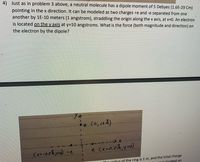Question

Transcribed Image Text:4) Just as in problem 3 above, a neutral molecule has a dipole moment of 5 Debyes (1.6E-29 Cm)
pointing in the x direction. It can be modeled as two charges +e and -e separated from one
another by 1E-10 meters (1 angstrom), straddling the origin along the x axis, at x-0. An electron
is located on the v axis at y=10 angstroms. What is the force (both magnitude and direction) on
the electron by the dipole?
(0,108)
----> x
e Cx =0.5Å,y-0)
Tho radius of the ring is 1 m, and the total charge
o is located on
Expert Solution
This question has been solved!
Explore an expertly crafted, step-by-step solution for a thorough understanding of key concepts.
Step by stepSolved in 2 steps

Knowledge Booster
Similar questions
- +8.0 µC and Qc = -2.0 µC. Consider three charges, QA = +6.0 µC, QB Charge Qais placed at point A = (-4.0,0) cm, charge QB is placed distance 4.0 cm from the origin, so that the line connecting it with origin makes an angle 0 = 60° with the negative x axis and charge Qc is at the origin. y QB QA What is the magnitude and direction of the electric force exerted by charges QA and QB on charge Qc?arrow_forwardConsider the figure with a symmetrical arrangement, in which la = 9b 48.55 μC, q. = qa = -8.55 µC, and q is positive. Using the symmetry of the arrangement, determine the direction of the force on charge q. down and right O right down up down and left up and left up and right left Calculate the magnitude of the force F on the charge q given that the square is 11.40 cm on a side and q 2.05 иС. F = Narrow_forwardAn electric dipole with dipole moment 4 x 10-9C m is aligned at 30* with the direction of a uniform electric field of magnitude 5 x 104NC 1. Calculate the magnitude of the torque acting on the dipole.arrow_forward
- A water molecule with any spatial orientation is placed nearby a spherical distribution of charges Q. Describe the dynamic behavior (rotation and translation) of the water molecule.arrow_forwardIn the early 1900's Robert Millikan discovered the peculiar property that charge came in little packets, no smaller than e = 1.602 x 10-19 C -- he had measured the charge of the electron. Here's (roughly) how he did it. He removed an electron from an initially neutral droplet of oil with diameter 0.5 ??μm. In a vacuum, he positioned the droplet between two metallic plates separated by 6 mm and fiddled with the potential (voltage) across the plates until the droplet would hover against the force of gravity. Droplets of this size with +e charge would hover, but only for a particular voltage (otherwise they would sink or rise). Given the parameters stated here, and the fact that the density of the oil was 831 kg/m3, what was the voltage that made the droplets hover? (give your answer with 0.1 V precision)arrow_forward
arrow_back_ios
arrow_forward_ios